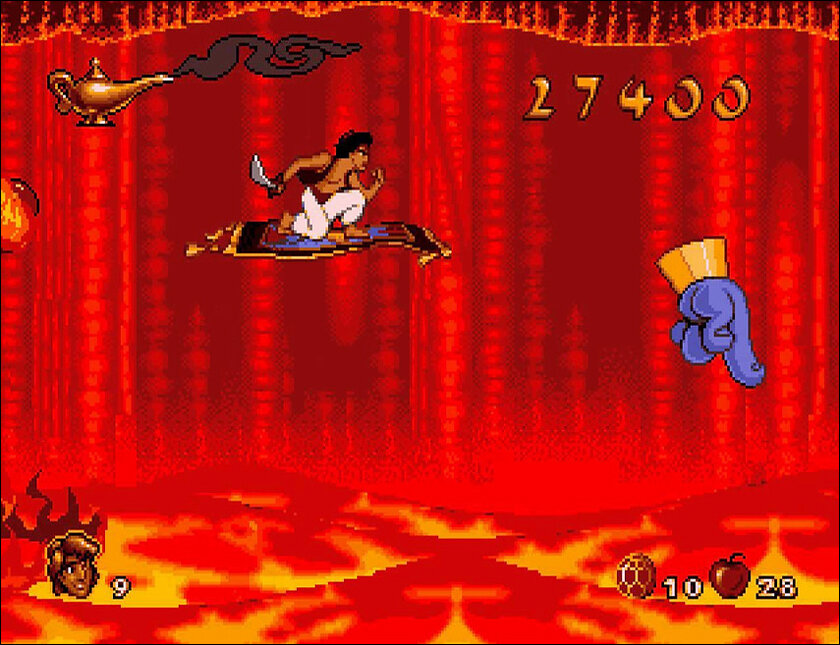‘Aladdin’ is more than just a game; it’s a portal to the cherished memories of our youth, says Dinesh Elumalai.
Let’s travel back to the Golden Era of gaming, early 1990s, when a fantastical story enchanted players both young and old. We were taken on a stunning voyage through the busy streets of Agrabah and the ethereal treasures of the Cave of treasures in “Aladdin,” the legendary computer game based on the Disney animated classic. This side-scrolling platformer was created and distributed by Virgin Interactive for a number of game systems, such as the Sega Genesis, Super Nintendo, and later the PC and Game Boy.
The game immediately became popular among fans of the animated movie because it immediately transported players to a world of vivid colors, entrancing music, and well-known characters. Players had to maneuver across perilous barriers, slip past security, and fight cunning foes like Jafar, the power-hungry sorcerer, as Aladdin, the brave young street urchin with aspirations of a better life.

One of the game’s distinguishing aspects was its outstanding animation, which complemented the movie’s aesthetic style. Aladdin’s flowing motions and emotional reactions reflected the essence of the film, further immersing players in the game’s universe. Players may also collect apples to toss at adversaries, bounce off springs to reach higher platforms, and ride a magic carpet, replicating some of the film’s most iconic sequences.
“Aladdin” was more than simply a tough game; it was a sentimental trip that brought back cherished memories of the famous Disney film while exposing a new generation to the marvels of the Arabian Nights. The game’s gorgeous visuals and fascinating gameplay have cemented its status as one of the most treasured 16-bit titles.
Years after its first release, “Aladdin” is still a testimony to the staying power of fond videogame memories. The enthralling story of a street-smart hero and a magical genie is still remembered for it to be more than simply a game. It served as a magical doorway that allowed players to repeat the story, leaving their identities indelible in the sands of time.
Certainly! The main character in “Aladdin” is controlled by the player as they walk across the screen from left to right, navigating different levels and overcoming obstacles as they go. This gameplay style is known as side-scrolling platforming.

Aladdin, the youthful protagonist from the Disney animated film, is portrayed by players. The main goal of the story is to save Princess Jasmine from the hands of Jafar, a wicked sorcerer, and Iago, his nefarious parrot sidekick. Players must advance through a number of levels-each with a unique theme and set of difficulties-in order to accomplish this aim.
Controls:
The game’s controls are pretty simple. On consoles, the directional pad was often used to move Aladdin left or right, as well as to crouch or glance up. To beat adversaries, there were other buttons for leaping and tossing apples.
Levels:
The game includes a number of stages, each inspired by a scene from the film. Players would go through Agrabah’s busy marketplace, leap across roofs, explore the perilous Cave of Wonders, and traverse the Sultan’s castle, among other things.
Obstacles and Enemies:
Throughout the stages, players will meet a variety of obstacles and foes. Bottomless pits and spikes, as well as guardians and desert monsters, are examples of this. Players had to precisely plan their leaps to avoid obstacles and eliminate foes with well-aimed apple tosses.
Collectibles:
Collectible goods, such as jewels and extra lives, were scattered around the levels for players to gather in order to improve their score and chances of success.
Magic Carpet Rides:
The magic carpet ride level, in which players soar through the skies on Aladdin’s faithful flying carpet, was one of the game’s most memorable features. Players had to escape impending obstacles and adversaries while collecting jewels and avoiding sliding off the carpet in this level.
Boss Battles:
At the conclusion of each level, players would face battle against tough bosses such as Jafar in his serpent form. To vanquish the opponents and advance to the next stage, these boss encounters required exact time and expertise.

The brilliant and colourful visuals of the game, together with its fascinating gameplay and sentimental tie-in to the popular Disney film, helped to make “Aladdin” a highly appreciated and enduring classic in the world of video gaming. It is still a fan favourite among Disney and vintage gaming aficionados, enthralling players with its enchanting allure.
Over the years, the game “Aladdin” has been released on a variety of gaming systems. Here are some of the important releases, along with their release dates:
1. Sega Genesis/Mega Drive:
- Release Date: November 11, 1993
- This version of the game was developed by Virgin Interactive and was one of the most popular and well-received versions.
2. Super Nintendo Entertainment System (SNES):
- Release Date: November 21, 1993
- This version was also developed by Virgin Interactive, but it had some differences in level design and gameplay compared to the Sega Genesis version.
3. Game Boy:
- Release Date: 1993
- The Game Boy version was developed by Virgin Interactive and was a handheld adaptation of the game. Due to hardware limitations, it had scaled-down graphics and simplified gameplay.

4. Nintendo Entertainment System (NES):
- Release Date: December 26, 1993 (Europe Only)
- This version, developed by Capcom, was exclusive to Europe and Brazil. It was not released in North America.
5. PC (DOS):
- Release Date: 1994
- The DOS version was a port of the Sega Genesis version and featured similar gameplay and graphics on PC.
6. Nintendo Virtual Console:
- Release Date: Various dates (as a digital download for Wii, Nintendo 3DS, and Wii U)
- In later years, “Aladdin” was made available as a digital download on Nintendo’s Virtual Console service for several of its gaming platforms.
Please keep in mind that there may have been further releases or ports of the game on various platforms throughout the years, but the versions mentioned above are some of the most popular and well-known versions of “Aladdin” that captivated players in the 1990s.
” A timeless classic that will transport you on a nostalgic magic carpet ride is “Aladdin.” This magical game, inspired by Disney’s iconic animated picture, continues to delight players of all ages. Our emotions are filled with the same wonder and excitement we had when we first witnessed Aladdin’s epic adventure as we go through the busy streets of Agrabah, dodge perilous barriers, and battle clever opponents.
Decades may have passed since its initial release, but ‘Aladdin’ remains an enduring symbol of the golden era of gaming. Its stunning animation, captivating gameplay, and memorable music make it a cherished gem that stands the test of time. The magic carpet rides still take our breath away, and the thrill of outsmarting Jafar and rescuing Princess Jasmine remains unmatched.

But ‘Aladdin’ is more than just a game; it’s a portal to the cherished memories of our youth. As we take that leap of faith and relive the magic, we find ourselves immersed in a world where imagination knows no bounds. The 16-bit graphics may be a reminder of a bygone era, but the feelings of joy, excitement, and triumph it evokes are as fresh as ever.
So, whether you’re a seasoned gamer revisiting cherished memories or a newcomer stepping into the sands of Agrabah for the first time, ‘Aladdin’ promises a magical journey like no other. Embrace the wonder, savour the adventure, and let the genie of nostalgia grant your gaming dreams. For in this captivating tale, the magic lives on, waiting to touch the hearts of generations to come.”









